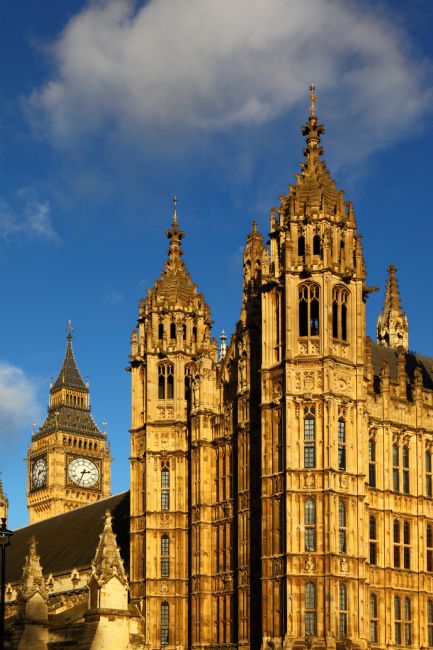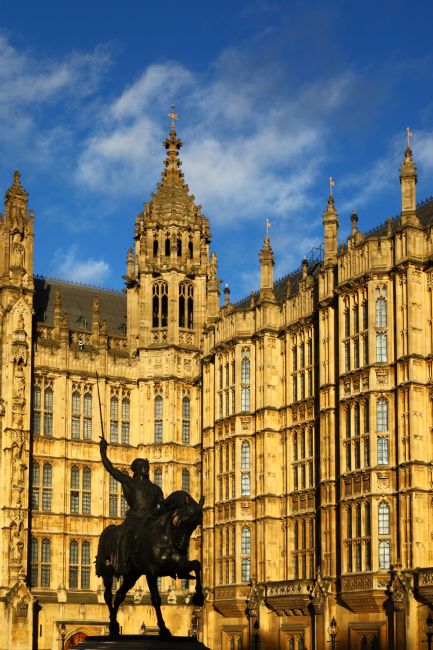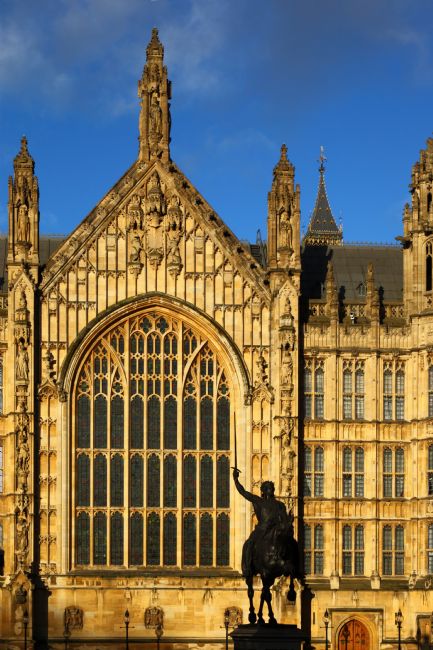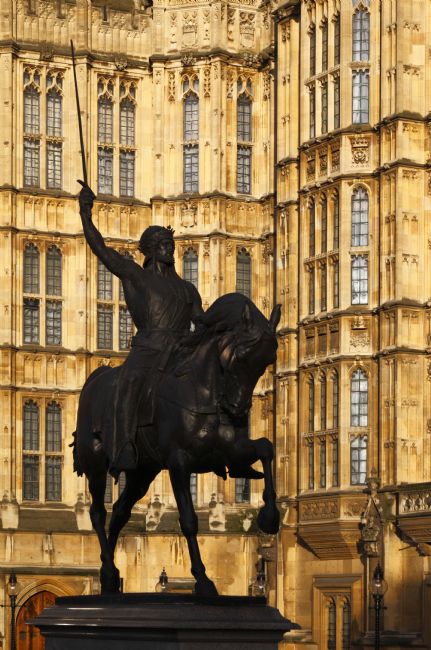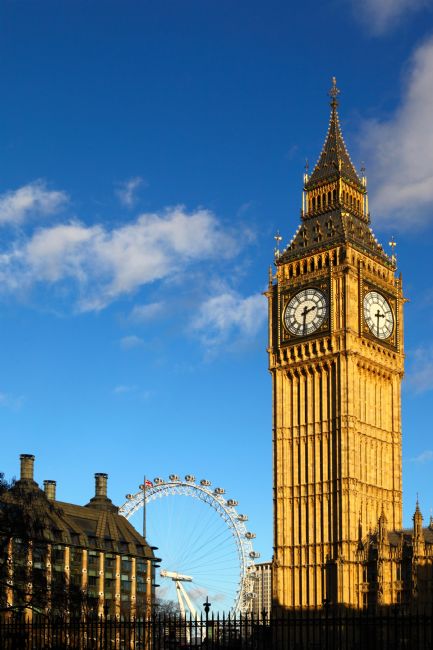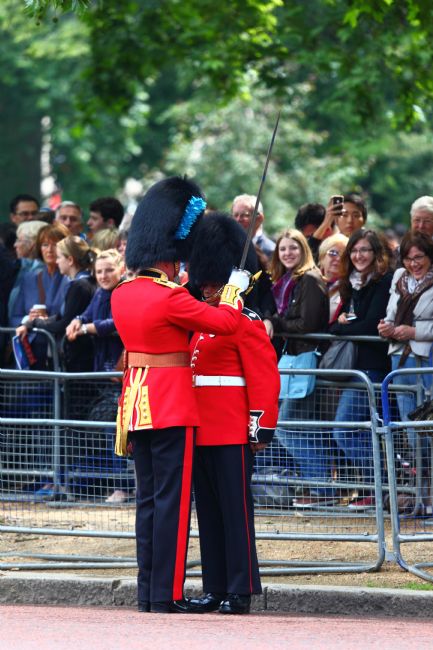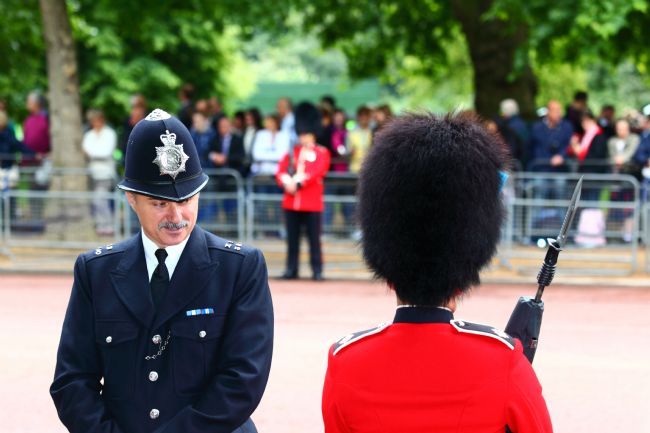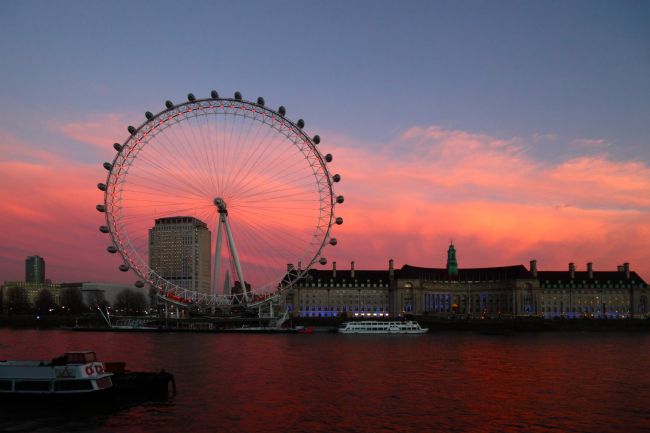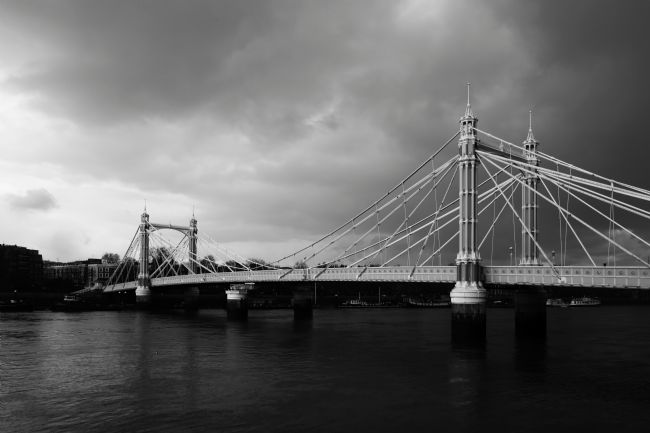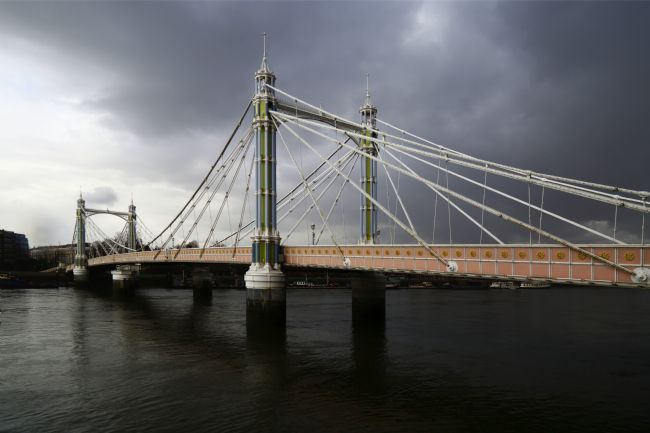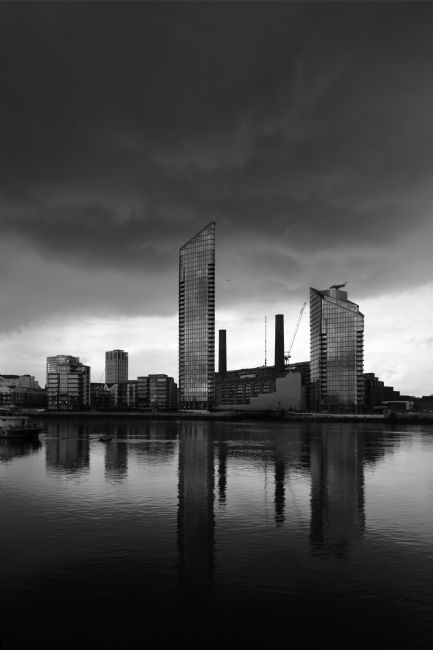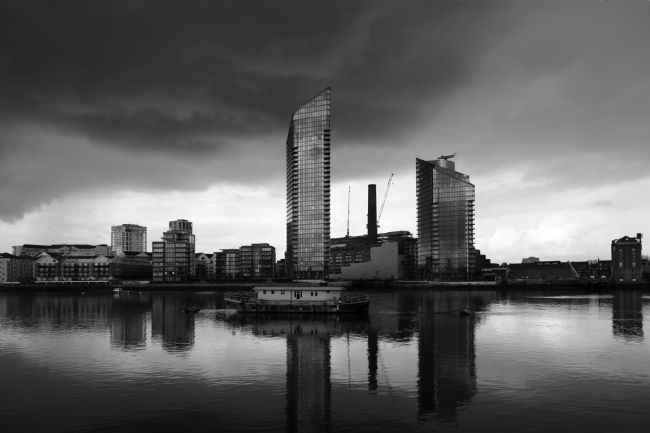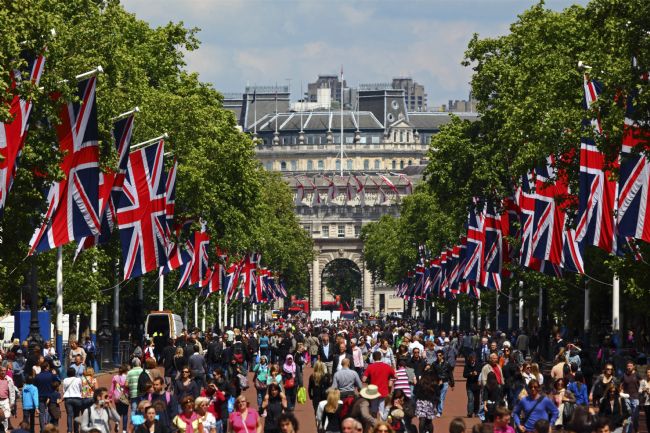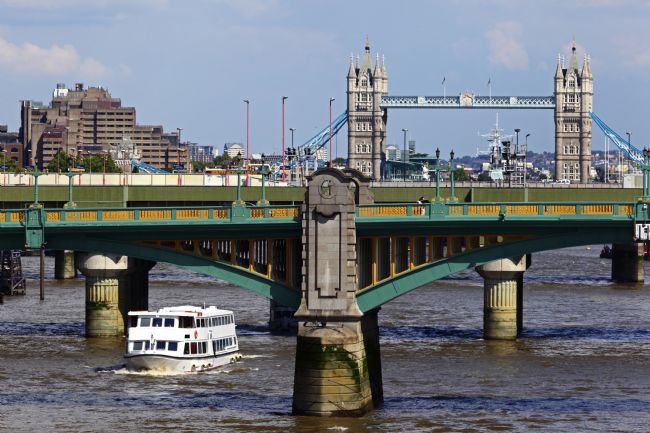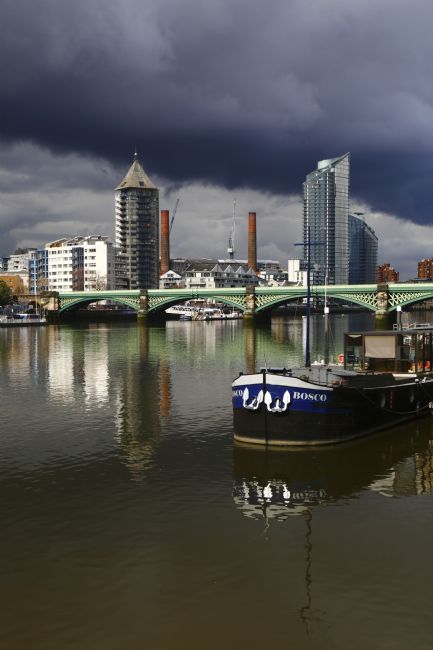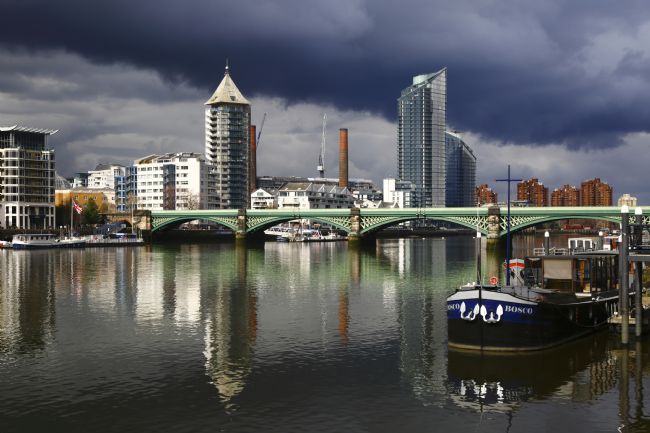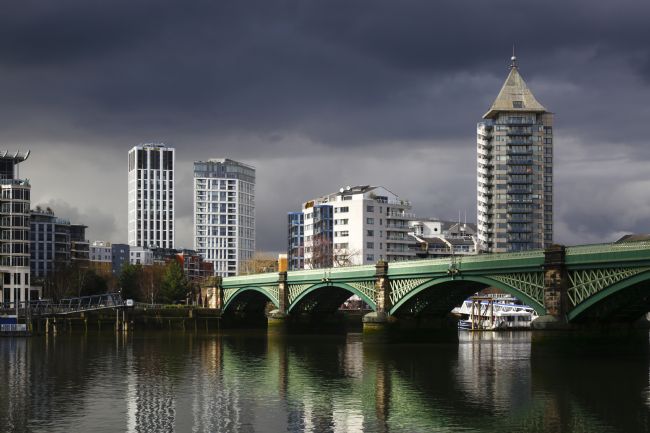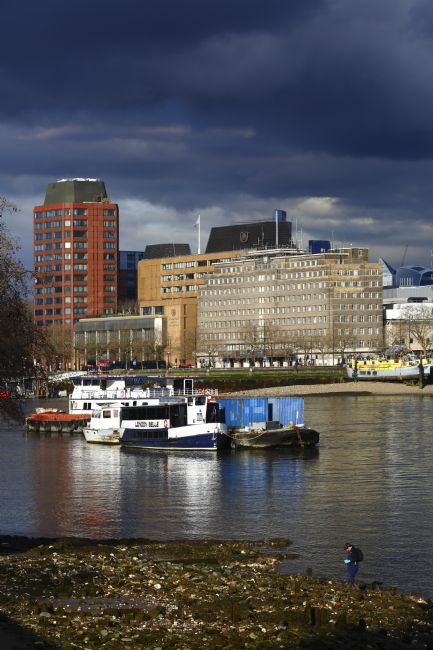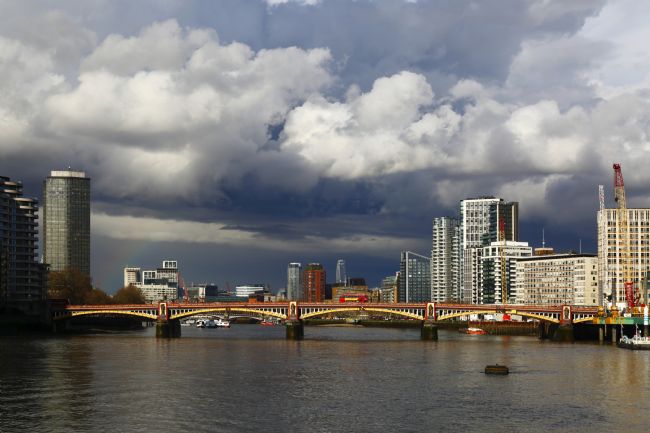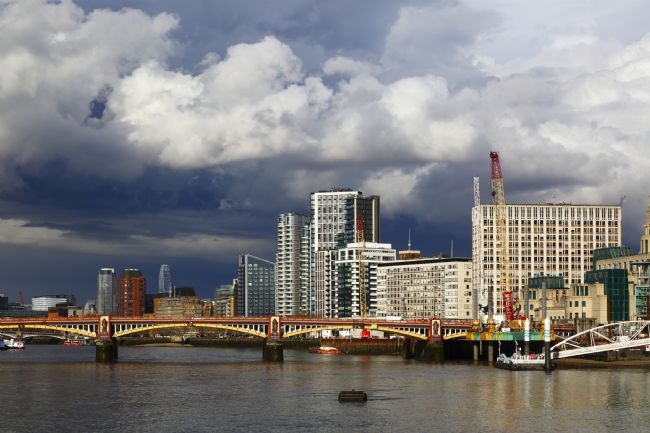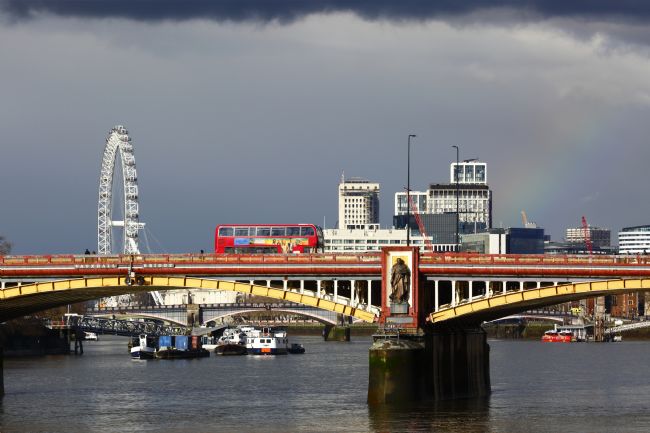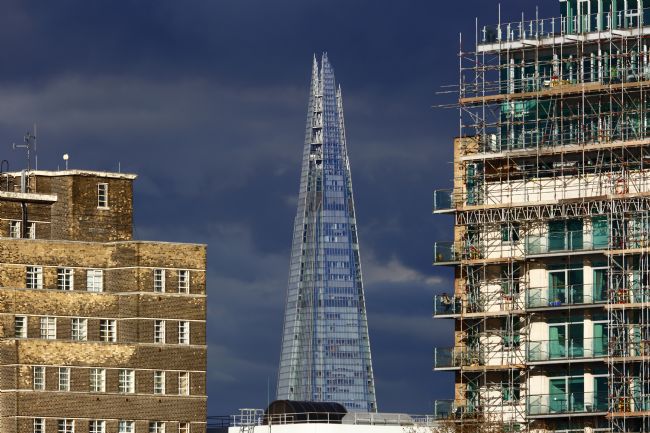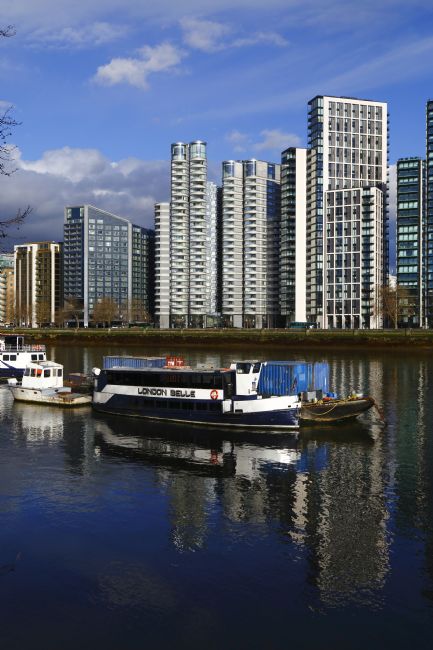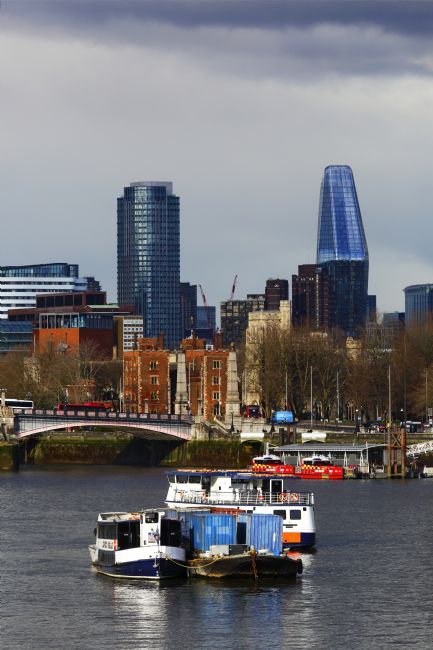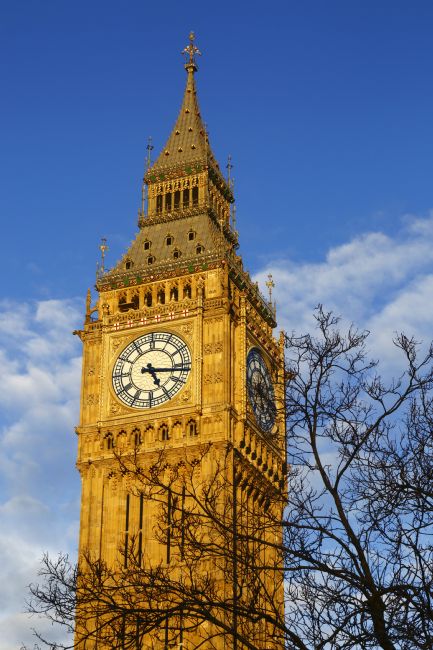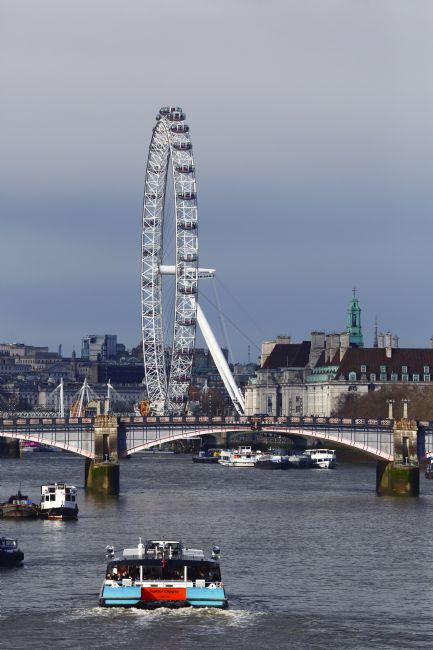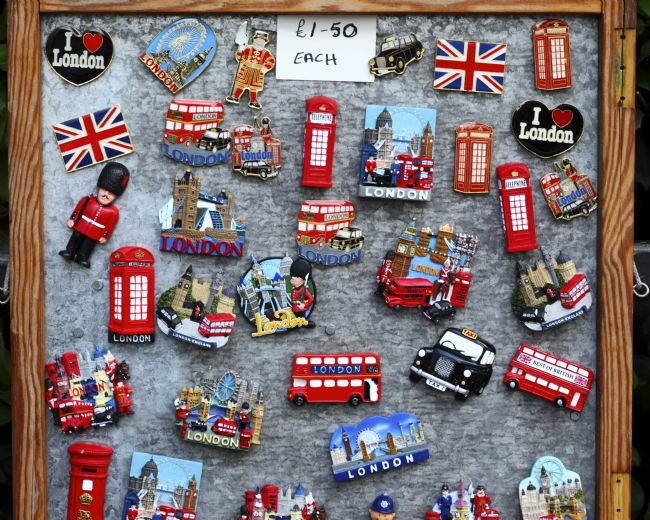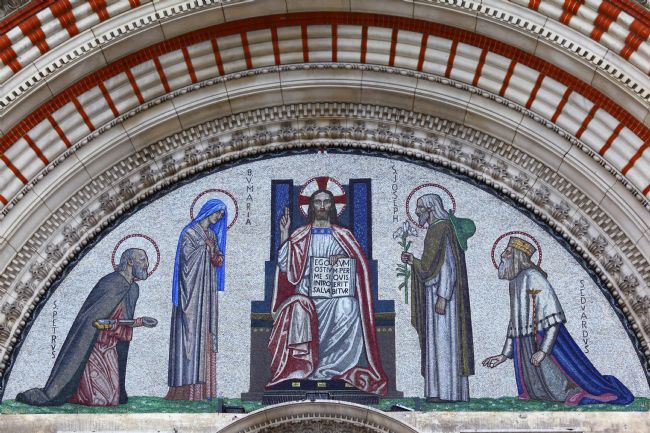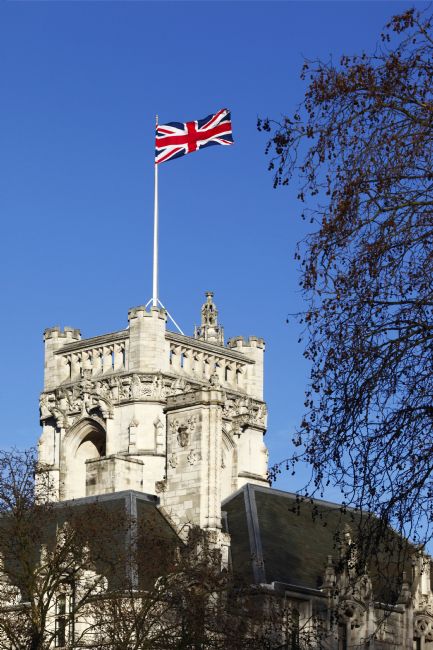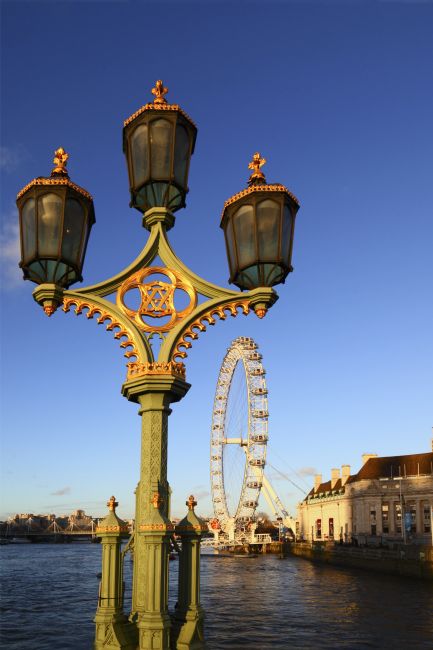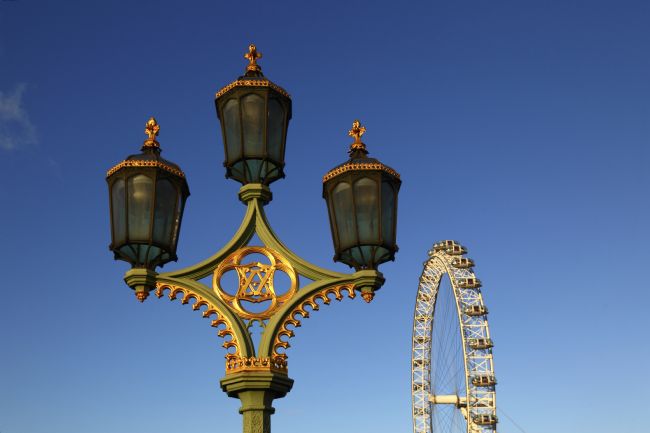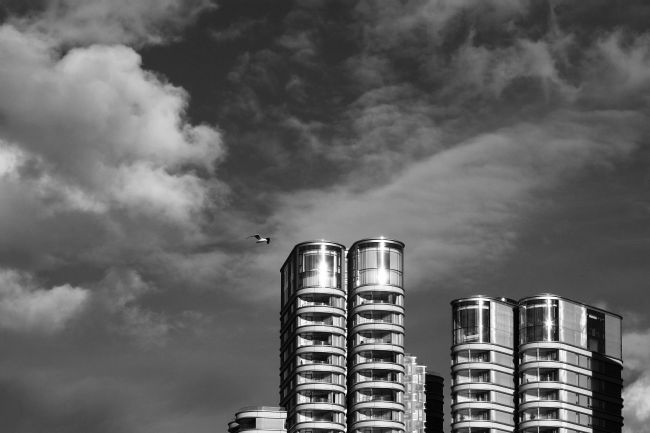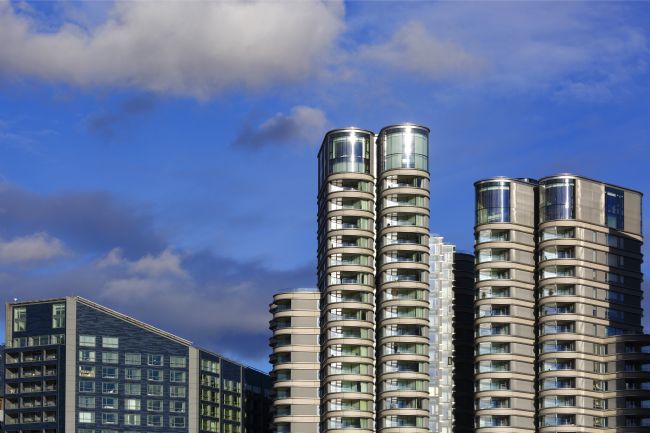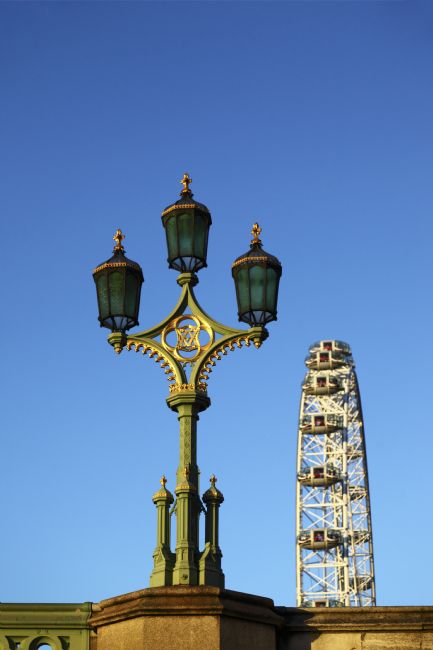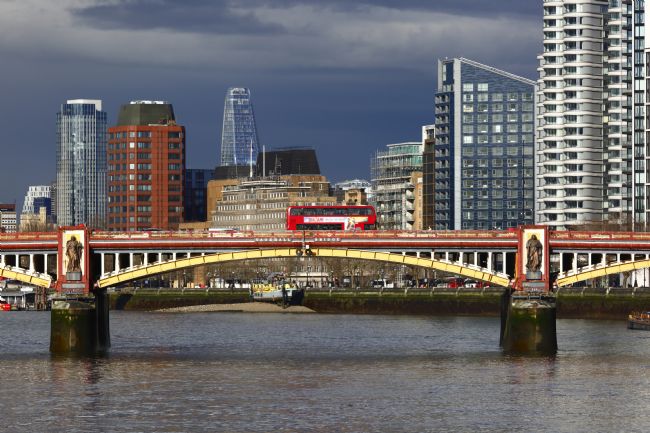A detail of some of the towers of the Palace of Westminster (also known as the Houses of Parliament), with the famous Big Ben clock tower in the background. Big Ben is actually the nickname of the largest bell inside the tower; the tower is officially called the Elizabeth Tower and houses the Great Clock of Westminster. The current Palace was built between 1840 and 1870 in the Gothic Revival style after a fire in 1834 destroyed most of the original Palace (parts of which dated from the 11th century).
A detail of one of the towers of the Palace of Westminster (also known as the Houses of Parliament), with the famous Big Ben clock tower in the background. Big Ben is actually the nickname of the largest bell inside the tower; the tower is officially called the Elizabeth Tower and houses the Great Clock of Westminster. The current Palace was built between 1840 and 1870 in the Gothic Revival style after a fire in 1834 destroyed most of the original Palace (parts of which dated from the 11th century).
This statue of King Richard I or Richard the Lionheart is in Old Palace Yard outside the Palace of Westminster / Houses of Parliament. Richard I was King of England from 6 July 1189 until his death on 6 April 1199 and is best known for his military exploits during the Crusades in the Middle East. The current Palace was built between 1840 and 1870 in the Gothic Revival style after a fire in 1834 destroyed most of the original Palace (parts of which dated from the 11th century).
This statue of King Richard I or Richard the Lionheart is in Old Palace Yard outside the Palace of Westminster / Houses of Parliament. Richard I was King of England from 6 July 1189 until his death on 6 April 1199 and is best known for his military exploits during the Crusades in the Middle East. The current Palace was built between 1840 and 1870 in the Gothic Revival style after a fire in 1834 destroyed most of the original Palace (parts of which dated from the 11th century).
This bronze statue of King Richard I or Richard the Lionheart is in Old Palace Yard outside the Palace of Westminster / Houses of Parliament. Richard I was King of England from 6 July 1189 until his death on 6 April 1199 and is best known for his military exploits during the Crusades in the Middle East. The statue was made by Baron Carlo Marochetti, completed in 1856 and has been in its present location since 1860.
View from Parliament Square of the famous Big Ben clock tower, with the London Eye ferris wheel in the background. The tower is part of the Palace of Westminster, also known as the Houses of Parliament. Big Ben is actually the nickname of the largest bell inside the tower, the tower is officially the Elizabeth Tower and houses the Great Clock of Westminster.
The view from the South Bank of the towers of the Palace of Westminster (also known as the Houses of Parliament) at sunset. On the right is the famous Big Ben clock tower, on the left is the Victoria Tower. Big Ben is actually the nickname of the largest bell inside the tower, the tower is officially called the Elizabeth Tower.
Two Scots guards appear to be sharing a sentry box while on duty outside Buckingham Palace. The Scots Guard are one of 5 regiments who make up the Queen's Guard, who are responsible for guarding Buckingham Palace and St James's Palace (including Clarence House). The regiment can trace their origins back to 1642.
Amused tourists watch while an Irish guard has his busby helmet adjusted by a superior officer before the Trooping the Colour ceremony. Since 1748 Trooping the Colour has also marked the official birthday of the British king or queen. It takes place on a Saturday in June and is a major London tourist attraction with parades by the various regiments of the Queen's Guard and Household Division.
A policeman chats with a royal guard in Pall Mall while waiting for the parades for the Trooping the Colour ceremonies. Since 1748 Trooping the Colour has also marked the official birthday of the British king or queen. It takes place on the 2nd Saturday in June and is an important tourist attraction with parades by regiments of the Queen's Guard and Household Division.
A beautiful pink sunset above the London Eye / Millennium Wheel and the County Hall building on the South Bank. The building behind the Eye is the Shell Centre (one of 2 central offices of the Shell oil company).
A view of Albert Bridge looking across the River Thames to the North Bank under a stormy sky. Arguably the most elegant bridge across the river in London, it connects Chelsea on the north bank to Battersea on the south. It was designed and built by Rowland Mason Ordish in 1873 as an Ordish–Lefeuvre system cable-stayed bridge, one of only two major bridges built with that system. Structural problems meant it was modified in the 1880s with some suspension bridge elements being added, the problems still continued when motor cars started to appear, meaning that traffic restrictions have been in place for most of its lifetime. The two concrete piers were added in 1973.
A view of Albert Bridge looking across the River Thames to the North Bank under a stormy sky. Arguably the most elegant bridge across the river in London, it connects Chelsea on the north bank to Battersea on the south. It was designed and built by Rowland Mason Ordish in 1873 as an Ordish–Lefeuvre system cable-stayed bridge, one of only two major bridges built with that system. Structural problems meant it was modified in the 1880s with some suspension bridge elements being added, the problems still continued when motor cars started to appear, meaning that traffic restrictions have been in place for most of its lifetime. The two concrete piers were added in 1973.
New apartment buildings, part of a huge redevelopment project on the Chelsea Waterfront on the North Bank of the River Thames in central London, under dramatic dark storm clouds. The chimneys between them are part of the Lots Road Power Station, a disused power station which supplied electricity to the London Underground system. It was completed in 1904 and finally shut down in 2002. The power station building is also part of the redevelopment project and due to be converted into shops, restaurants and apartments.
New apartment buildings, part of a huge redevelopment project on the Chelsea Waterfront on the North Bank of the River Thames in central London, under dramatic dark storm clouds. The chimney between them is part of the Lots Road Power Station, a disused power station which supplied electricity to the London Underground system. It was completed in 1904 and finally shut down in 2002. The power station building is also part of the redevelopment project and due to be converted into shops, restaurants and apartments.
Crowds of people and rows of Union Jack flags in Pall Mall in London, England. Pall Mall is one of London's most famous streets. It connects the Victoria Memorial in front of Buckingham Palace to Trafalgar Square; the arch in the photo is part of the Admiralty Arch at the northeast / Trafalgar Square end of The Mall. This image was taken after the parades for the Trooping the Colour, a ceremony performed by regiments of the British and Commonwealth armies that also marks the official birthday of the King or Queen. It takes place on a Saturday in June and is a major London tourist attraction.
A view looking east along the River Thames in London, with a cruise boat about to pass under Southwark Bridge. In the background is Tower bridge, a combined bascule and suspension bridge that is one of the world's most famous bridges and an iconic London landmark. It was designed by Horace Jones and built between 1886 and 1894.
A view of the River Thames and Battersea Railway Bridge on a stormy afternoon. The bridge was designed by William Baker, the chief engineer of the London and North Western Railway, and opened in March 1863. Nowadays it is officially called the Chelsea River Bridge by its owners Network Rail Infrastructure Ltd, and is used by the West London Line of the London Overground. The modern high rises on the right are apartment buildings that are part of a huge new development project on the Chelsea Waterfront. The brick chimneys are part of the Lots Road Power Station, a disused power station that supplied electricity to the London Underground system. The high rise building on the left is the Belvedere Tower, Chelsea Harbour, which also contains luxury apartments. The boat in the foreground is part of a moored houseboat community.
A view of the River Thames and Battersea Railway Bridge on a stormy afternoon. The bridge was designed by William Baker, the chief engineer of the London and North Western Railway, and opened in March 1863. Nowadays it is officially called the Chelsea River Bridge by its owners Network Rail Infrastructure Ltd, and is used by the West London Line of the London Overground. The modern high rises on the right are apartment buildings that are part of a huge new development project on the Chelsea Waterfront. The brick chimneys are part of the Lots Road Power Station, a disused power station that supplied electricity to the London Underground system. The high rise building on the left is the Belvedere Tower, Chelsea Harbour, which also contains luxury apartments. The boat in the foreground is part of a moored houseboat community.
A view of the River Thames and Battersea Railway Bridge on a stormy afternoon. The bridge (a Grade 2 listed structure) was designed by William Baker, the chief engineer of the London and North Western Railway, and opened in March 1863. The bridge links Battersea to the part of Fulham known as Chelsea Harbour or Imperial Wharf on the south side of Chelsea Creek. Nowadays it is officially called the Chelsea River Bridge by its owners Network Rail Infrastructure Ltd, and is used by the West London Line of the London Overground. The high rise building on the right is the Belvedere Tower, Chelsea Harbour, which contains luxury apartments.
A person looks for artefacts on the northern foreshore of the River Thames in central London at low tide on a stormy afternoon. The buildings opposite are on the Albert Embankment and include the Westminster Tower (L) and International Maritime Organization offices (centre). The word mudlark was commonly used in the 18th and 19th centuries to describe people who made a living in this way, selling whatever finds they could. Modern mudlarks are often amateur historians and hobbyists using metal detectors to search for artefacts and require a licence to operate which is administered jointly by the Port of London Authority or the Crown Estate (the largest land owners of Thames foreshore).
A red London bus crossing the New Vauxhall Bridge, which was designed by Sir Alexander Binnie (the resident engineer of the London County Council) and opened in May 1906. It replaced the older Regent Bridge that had occupied the site since 1816 and is now one of the busiest road bridges in central London. Notable buildings in this image are the Millbank Tower (far L), the Westminster Tower (centre distance) with the South Bank Tower to its L and the pointed skyscraper at One Blackfriars Road, also known as "The Boomerang", in Bankside on its right.
The New Vauxhall Bridge was designed by Sir Alexander Binnie (the resident engineer of the London County Council) and opened in May 1906. It replaced the older Regent Bridge that had occupied the site since 1816 and is now one of the busiest road bridges in central London. The bronze statues above the piers were added in 1907. Notable buildings in this image are the red Westminster Tower (left centre) with the South Bank Tower to its left and the pointed skyscraper at One Blackfriars Road, also known as "The Boomerang", in Bankside on its right. The modern buildings in the centre are new redevelopment along the Albert Embankment, including the Park Plaza London Riverbank Hotel (the dark grey building with the sloping roof).
The New Vauxhall Bridge was designed by Sir Alexander Binnie (the resident engineer of the London County Council) and opened in May 1906. It replaced the older Regent Bridge that had occupied the site since 1816 and is now one of the busiest road bridges in central London. The bronze statues above the piers were added in 1907. The London Eye (also known as the Millennium Wheel) officially opened to the public on 9th March 2000 and is now the most popular paid tourist attraction in the UK.
A view of The Shard building from the Millbank area, contrasting with older apartment buildings in the foreground. The Shard is located next to London Bridge Station in Southwark, has 72-storeys and is 309.6m / 1,016ft high. It is still the tallest building in the United Kingdom, when it was completed in 2012 it was briefly the tallest building in Europe (it now ranks as 7th tallest). Apart from The Shard, the other thing that caught my eye in this shot was the couple sitting out on their balcony about half way up the building on the right, oblivious to the views and all the scaffolding surrounding them!
Reflections of the M. V. London Belle and modern buildings that are part of new redevelopment along the Albert Embankment on the South Bank of the A view across the River Thames. The dark gray building on the left with the sloping roof is the Park Plaza London Riverbank Hotel. The London Belle is one of several boats that can be hired for cruises, corporate events and parties on the river.
A view looking northeast along the River Thames towards Lambeth Bridge. The skyscrapers are the South Bank Tower (left) and 1 Blackfriars Road (right, also known as The Boomerang) in Bankside. The historic brick building in the centre next to the bridge is the late 15th century Tudor brick gatehouse known as Morton's Tower, an entrance to Lambeth Palace (the official London residence of the Archbishop of Canterbury). To its right is St Mary-at-Lambeth church tower.
The view looking northeast along the River Thames, London towards Lambeth Bridge. The 2 glass skyscrapers in the centre background are the South Bank Tower (left) and 1 Blackfriars Road (right, also known as The Boomerang) in Bankside. The red tower block mid-right is the Westminster Tower, to its right the International Maritime Organization (IMO) offices. The historic brick building in the centre next to the bridge is Morton's Tower, the late 15th century gatehouse that is an entrance to Lambeth Palace (the official London residence of the Archbishop of Canterbury).
Late afternoon sunshine lights up the Elizabeth Tower, which houses the world famous Great Clock of Westminster. Big Ben, the common name, is actually the nickname of the largest of the 5 bells inside the tower. The exterior is clad with sand-coloured Anston limestone bricks which glow with a beautiful golden colour in the right light.
A view looking north along the River Thames towards Lambeth Bridge, with the London Eye ferris wheel in the background. The boat in the foreground is the Jupiter Clipper, one of the Thames Clipper River Buses (a high-speed water taxi service). The building on the right with the green tower is County Hall.
A selection of fridge magnets in the design of London and English icons for sale on a street stall. Red double decker buses, the black cabs, Royal Guards, post and phone boxes are all present.
A detail of the mosaics on the tympanum above the main entrance of Westminster Cathedral in London. The cathedral is the largest Catholic church in the UK, the mother church of the Roman Catholic Church in England and Wales and the seat of the Archbishop of Westminster.
The neo-Byzantine style cathedral was built almost entirely of brick, concrete and stone and completed in 1903. Its mosaics were added later. This mosaic Christ Enthroned above the entrance to the cathedral depicts Jesus as the Christ Pantocrator (usually translated as Almighty or all-powerful) flanked by the Virgin Mary and St Joseph holding a lily flower. Far left is St Peter with the Keys of Heaven, far right the canonized English King Edward the Confessor in royal regalia. Jesus is holding the Book of Life.
A detail of the Christ Enthroned mosaic on the tympanum above the main entrance of Westminster Cathedral in London. The cathedral is the largest Catholic church in the UK, the mother church of the Roman Catholic Church in England and Wales and the seat of the Archbishop of Westminster.
The neo-Byzantine style cathedral was built almost entirely of brick, concrete and stone and completed in 1903; its mosaics were added later. This mosaic above the main entrance depicts Jesus as the Christ Pantocrator (usually translated as Almighty or all-powerful) flanked by the Virgin Mary and St Joseph holding a lily flower. Jesus is holding the Book of Life.
The Union Jack flag above the Middlesex Guildhall building in London on a sunny winter's day. The building is located on the southwest corner of Parliament Square in Westminster (close to Westminster Abbey). Since 2009 it is the home of both the Supreme Court of the United Kingdom and the Judicial Committee of the Privy Council. Construction started in 1906, the Guildhall originally served as an administrative and court centre for the County of Middlesex, hence the name.
One of the ornate street lamps on Westminster Bridge in central London, with the London Eye / Millennium Wheel in the background. The current seven-arch, cast-iron bridge was designed by Thomas Page and opened in May 1862. The Gothic detailing is by Charles Barry, the architect of the Palace of Westminster.
One of the ornate street lamps on Westminster Bridge in central London, with the London Eye / Millennium Wheel in the background. The current seven-arch, cast-iron bridge was designed by Thomas Page and opened in May 1862. The Gothic detailing is by Charles Barry, the architect of the Palace of Westminster.
A seagull flies over some of the modern apartment buildings that are part of new redevelopment along the Albert Embankment on the South Bank.
A detail of some of the modern apartment buildings that are part of new redevelopment along the Albert Embankment on the South Bank. The dark gray building far left with the sloping roof is the Park Plaza London Riverbank Hotel.
One of the ornate street lamps on Westminster Bridge in central London, with the London Eye / Millennium Wheel in the background. The current seven-arch, cast-iron bridge was designed by Thomas Page and opened in May 1862. The Gothic detailing is by Charles Barry, the architect of the Palace of Westminster.
The New Vauxhall Bridge was designed by Sir Alexander Binnie (the resident engineer of the London County Council) and opened in May 1906. It replaced the older Regent Bridge that had occupied the site since 1816 and is now one of the busiest road bridges in central London. The bronze statues above the piers were added in 1907. The pointed skyscraper just left of centre is One Blackfriars Road, also known as "The Boomerang", in Bankside. It is one of several new modern high rise buildings on the South Bank in central London; it was completed in 2018 and is 166m / 546ft tall. To its left are the red Westminster Tower and the South Bank Tower. The modern buildings on the right are new redevelopment along the Albert Embankment, including the Park Plaza London Riverbank Hotel (the dark grey building with the sloping roof).
